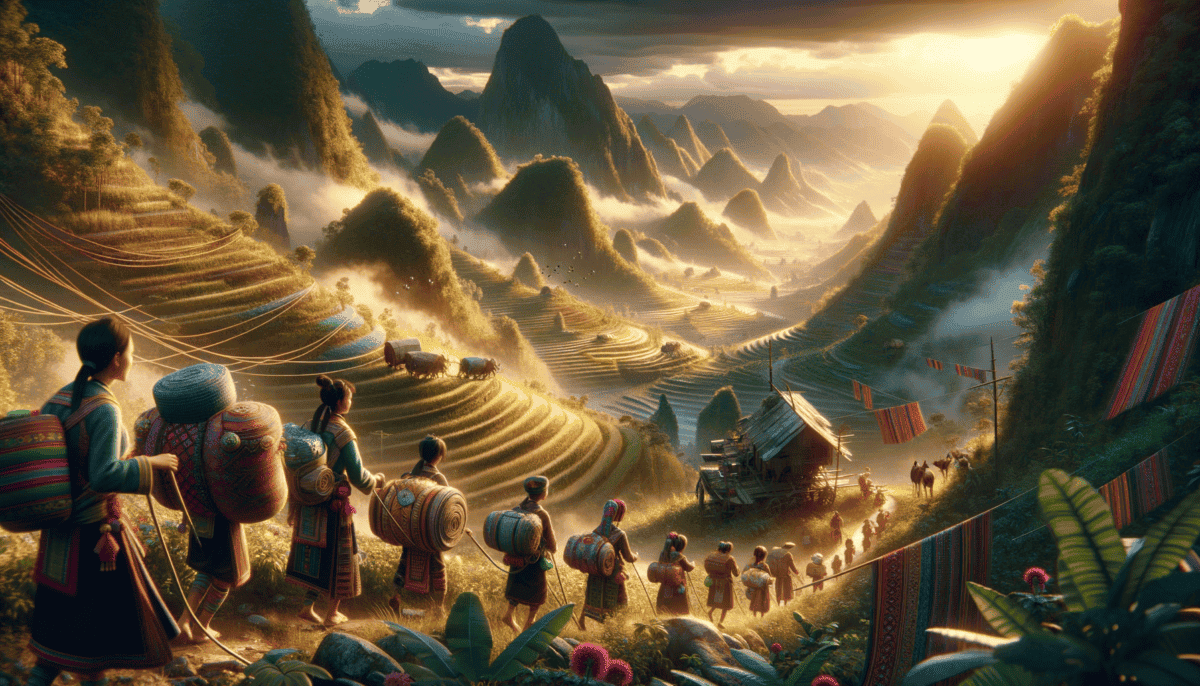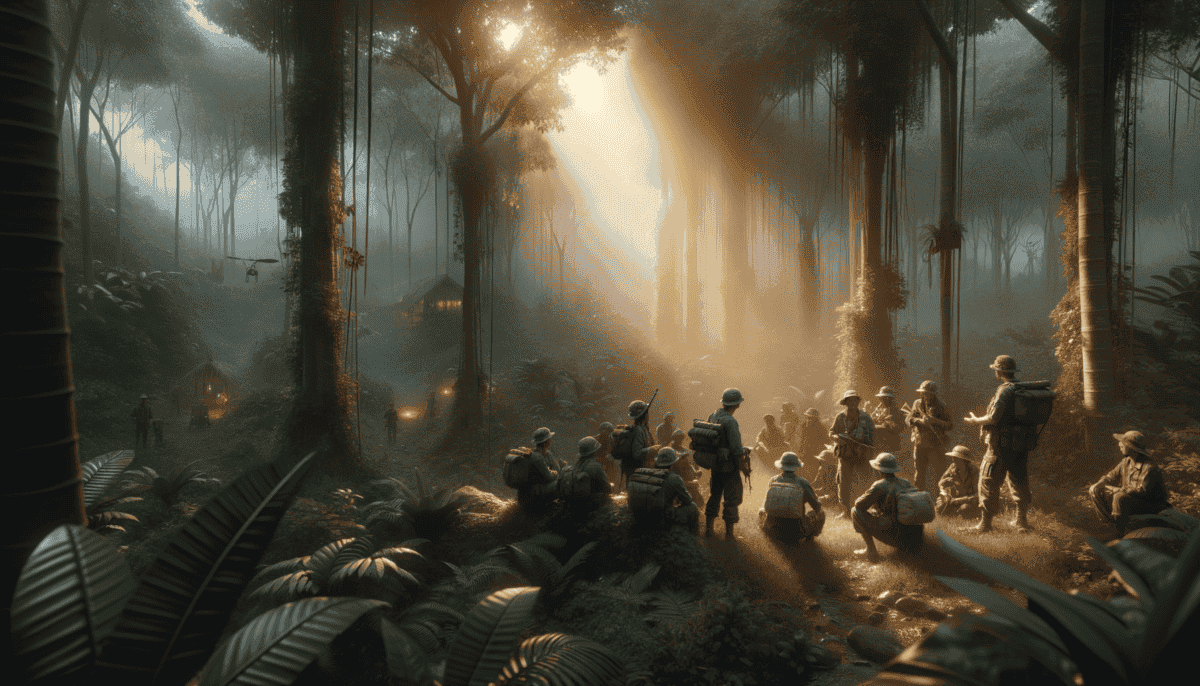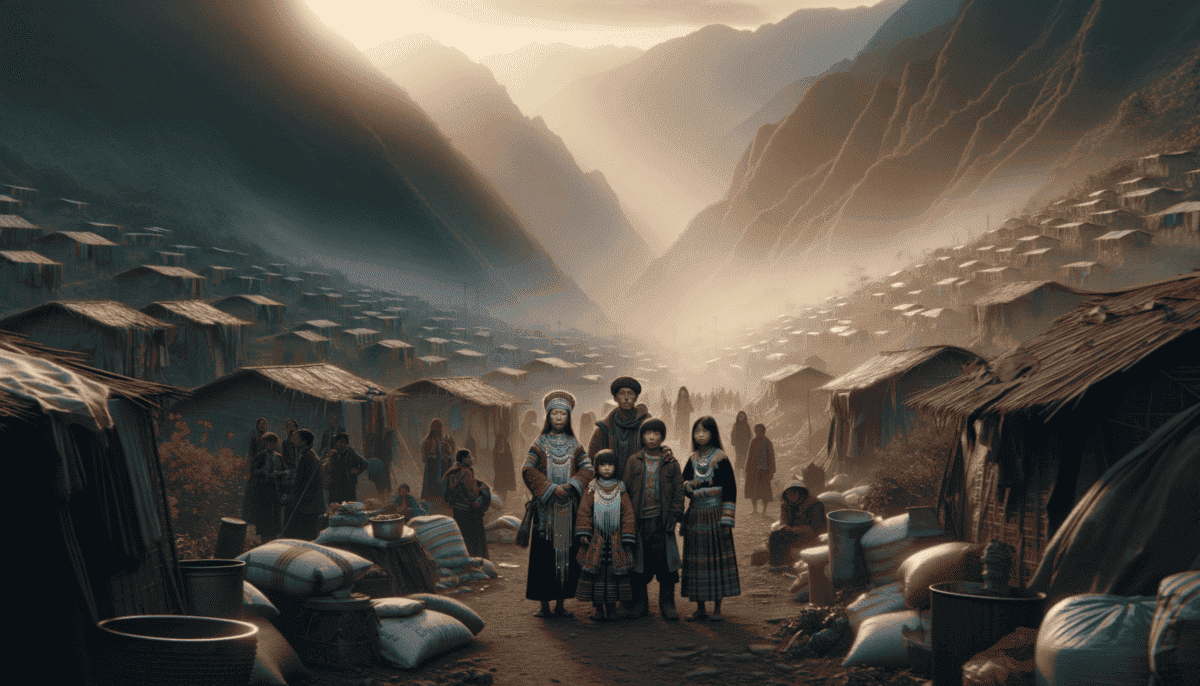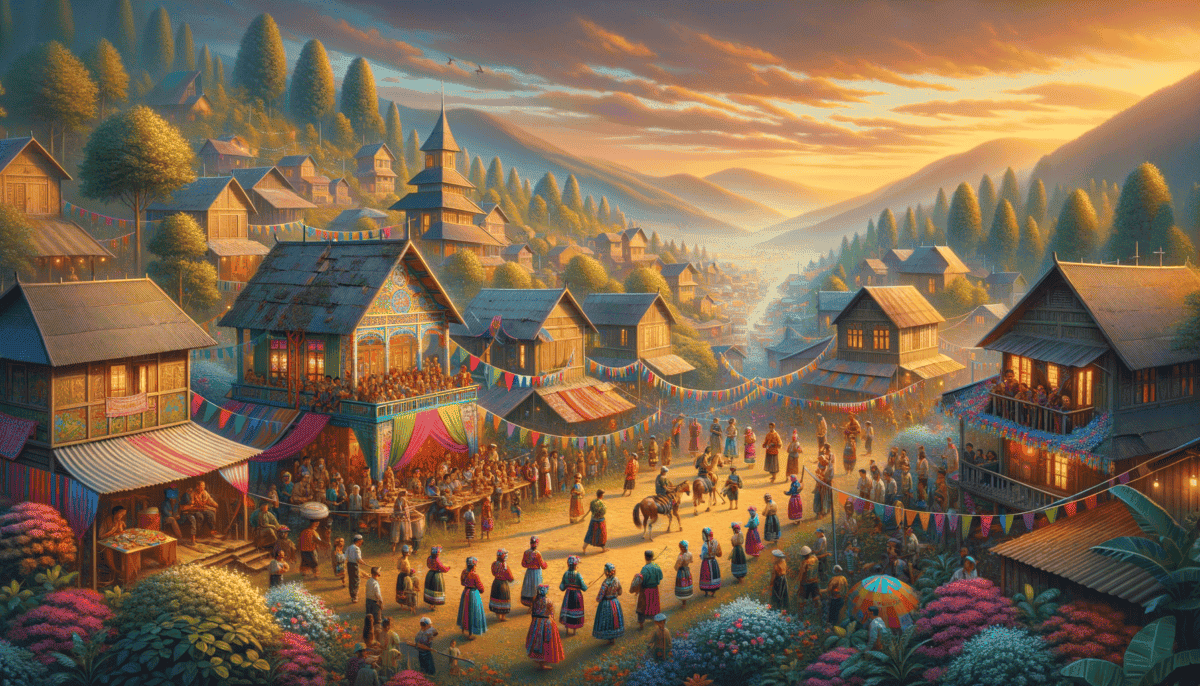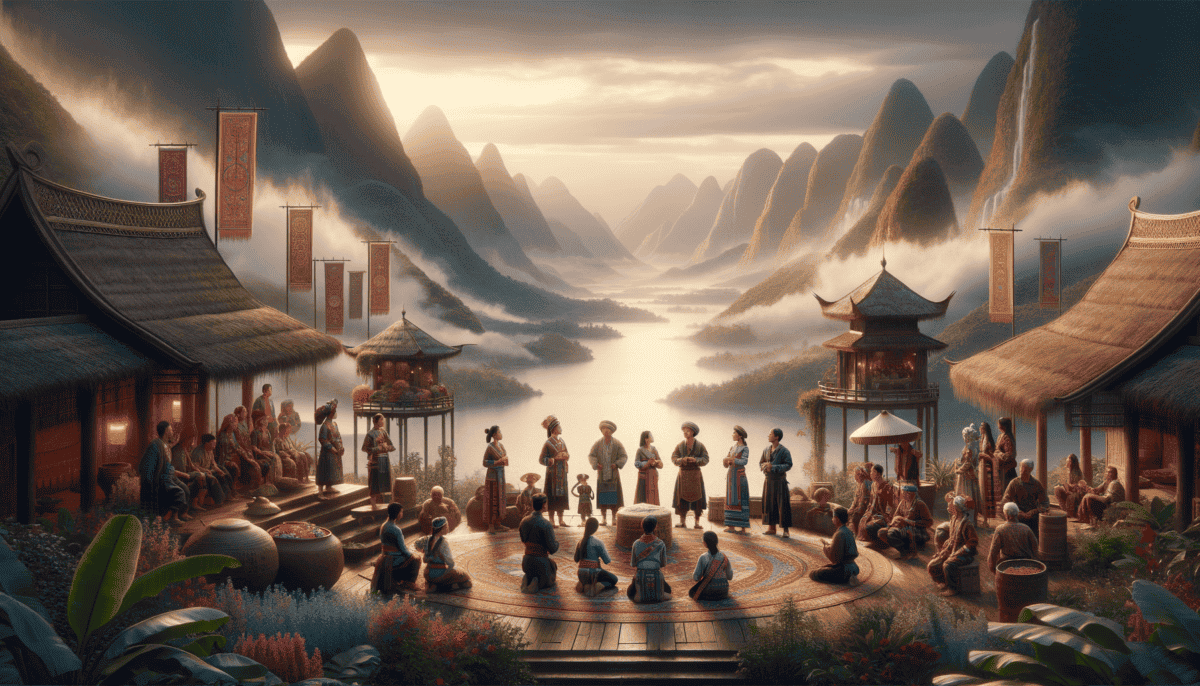Roots in the Mountains
High in the misty mountains of China, where clouds touched the treetops, lived the Hmong people. Their village sat like a nest among tall green peaks. Little Mai, a bright-eyed seven-year-old girl, loved to watch the morning sun paint the sky pink from her family's wooden house.
"Grandmother, tell me again about our people," Mai would say each morning as she helped feed the chickens.
Grandmother Yu smiled, her wrinkled face full of wisdom. "Our story begins here in these mountains, little one. The Hmong have lived here for thousands of years – as long as the oldest trees have grown."
Every day in the village was full of busy hands and happy voices. Women wore beautiful clothes they made themselves, with rainbow-colored patterns that told stories without words. Men worked in the fields, growing rice and corn on the steep hillsides.
"Look, Mai," Grandmother Yu pointed to the terraced fields that looked like giant steps carved into the mountainside. "Our people are clever. We learned to farm on mountains when others said it couldn't be done!"
Mai loved watching the village come alive each morning:
• Her mother weaving bright cloth on her loom
• Her father tending to the green corn stalks
• Children playing with tops made from bamboo
• Elders teaching young ones about healing plants
• The whole village gathering to share meals
The Magic of Mountain Life
At night, the village would gather around fires to share stories. The flames danced as elders told tales of brave ancestors and magical spirits. Mai's favorite was the story of how the Hmong first came to the mountains.
"We chose the highest places," Grandfather Chen would say, his voice deep and warm like honey. "Up here, we could be free. We could keep our own ways." ️
One special day, Mai watched her mother sew a new pattern into a cloth. "Each stitch tells our story," her mother explained. "This is how we remember who we are, even when times change."
The air smelled of pine trees and cooking fires. Music filled the evening as people played reed pipes and drums. Young ones danced while babies slept in colorful slings on their mothers' backs.
But sometimes, Mai noticed worried looks on the grown-ups' faces. They would talk quietly about changes coming to their mountain home. New people were moving closer. Some families had already left to find new places to live.
"Why do we have to move?" Mai asked one evening.
Grandmother Yu hugged her close. "Sometimes, little one, the wind blows in new directions, and we must be like the birds – ready to fly to new nests. But remember, wherever we go, we carry our stories, our songs, and our hearts with us."
That night, as Mai drifted to sleep under her warm blanket, she heard the mountain winds whisper through the trees. She didn't know it yet, but big changes were coming to her village. The Hmong people would soon face their biggest journey yet.
Winds of Change
The morning sun rose differently now over Mai’s village. More strangers passed through their mountain paths. The peaceful rhythm of village life began to change.
“Pack only what you can carry,” Mai’s father told the family one dawn. “We must join the others moving south.”
Mai watched as her mother carefully folded their story cloths – precious pieces of fabric that held their history in colorful stitches. Grandmother Yu packed her special herbs and healing plants.
The Great Journey South
“Why must we leave?” Mai asked, holding her favorite wooden doll tight.
Grandfather Chen knelt beside her. “Sometimes, little flower, we must find new soil to grow in. The mountains have many paths, and our people know how to walk them all.”
The journey was long and hard. Mai’s feet had never walked so far. They traveled with other Hmong families:
• Through thick forests and over high peaks
• Across rushing rivers and wide valleys
• Past strange villages and new faces
• Under hot suns and through heavy rains
• Into lands with different languages
“Look how the land changes,” Grandmother Yu would say, pointing out new plants and animals. “But see how our people change too – we learn, we grow, we become stronger.”
Finding New Homes
After many moons of walking, Mai’s family reached a new mountain in a place called Laos. Other Hmong families were already there, building houses and planting crops.
“This will be our new home,” Mai’s father said, his eyes tired but hopeful.
The new village grew quickly. Mai watched as:
“Houses rose from the ground like bamboo after rain
Gardens sprouted with familiar plants from saved seeds
New friendships bloomed between families
Old traditions found new soil to grow in”
Mai noticed differences in their new home. The air felt warmer. The trees looked different. Strange birds sang new songs. But some things stayed the same – the way her people worked together, their music, their stories.
One evening, as the family sat around their new fire, Mai asked, “Are we still Hmong here?”
Grandmother Yu smiled, taking out her embroidery. “We are Hmong wherever we go, little one. Like a tree, our roots grow deep, even in new soil. Watch – I will teach you to sew our story into this cloth, so you never forget.”
As Mai learned to make the tiny stitches, she heard new sounds mixing with old ones – different languages, unfamiliar music, the bustle of nearby towns. Change was coming again, faster than before, bringing both worry and hope to their mountain home.
The Secret War Begins
The peaceful mountain life Mai’s family had built in Laos changed when strange planes began flying overhead. ✈️ The year was 1960, and a hidden war was about to begin.
“Something big is happening,” Mai’s father whispered one night. American soldiers had come to their village, speaking with the village leaders.
Mai watched as her older brother Cha, now grown tall and strong, joined other young men for special training. They learned to:
- Send secret messages
- Help lost pilots
- Guard important mountain paths
- Protect their villages
- Guide American soldiers through the jungle
Brave Hearts in Dark Times
“Why are you helping the Americans?” Mai asked Cha one evening.
Cha smiled sadly. “To protect our new home, little sister. The mountains have always kept us safe. Now it’s our turn to keep the mountains safe.” ️
“We are mountain people,” Grandmother Yu added. “We see what others cannot see. We know paths others cannot find. This makes us special.”
Life became different. Mai helped her mother pack food for the soldiers. At night, she could hear distant sounds that made her scared. But her family stayed brave.
Changes in the Village
More changes came to the village:
• New medicines from American doctors
• Radio sets for sending messages
• Different kinds of food
• American soldiers teaching English words
• Helicopters bringing supplies
Mai learned some English words from the friendly American soldiers. “Thank you,” she would say when they gave her candy.
But not everything was good. Some nights, Mai’s mother would hold her tight when loud noises came from far away. Many families from other villages came to live with them, running from danger.
“Our people are strong,” Father would say. “Like bamboo, we bend but do not break.”
A Time of Worry
One day, Cha came home with serious news. The fighting was getting closer. More Hmong villages needed help.
“What will happen to us?” Mai asked, clutching her story cloth.
Grandmother Yu pulled her close. “Remember, little one – our people have faced hard times before. We carry our strength in our hearts, our stories in our hands, and our hope in our spirits.” ❤️
The village became busier. More soldiers came and went. Mai helped her mother cook for tired fighters. She watched as her brother and other brave Hmong men disappeared into the forests for days, helping to keep their people safe.
Survival and Separation
The year was 1975. Mai sat in the dark, holding her precious story cloth close. The sounds of helicopters filled the night sky.
The Night of Many Tears
“We must go now,” Father whispered urgently. “Take only what you can carry.”
Mai’s hands shook as she packed her small bag:
- The story cloth from Grandmother Yu
- A tiny bag of rice
- Her warm jacket
- A family photo
- A silver necklace from her mother
“Remember,” Grandmother Yu said softly, “our stories live in our hearts, not just in our things.”
The Long Walk
That night, Mai’s family joined many others walking through the dark mountains. Little children tried not to cry. Parents carried babies. Old people walked slowly but bravely.
“Where are we going?” Mai whispered to her brother Cha.
“To Thailand,” he answered. “There are safe places there for our people.”
Life Changes Again
After many hard days, they reached a place called a refugee camp. It was very different from their mountain home:
• Many families lived close together
• They slept in small houses made of bamboo
• They had to wait in long lines for food
• There were new rules to follow
• They met Hmong people from other villages
Keeping Traditions Alive
In the camp, Grandmother Yu gathered children every evening. She taught them old Hmong stories and songs. She showed them how to make story cloths.
“This is how we keep our memories,” she said, helping Mai with her stitches. “Each thread tells part of our story.”
“Even if we are far from our mountains, our traditions make us strong. They remind us who we are.”
New Hopes and Worries
One day, exciting news came. Some families would go to a place called America. Others would go to France or Australia.
“Will we all stay together?” Mai asked, worried.
Father hugged her tight. “Our family will stay together. But some of our friends will go to different places. We must be brave.”
Mai looked at her story cloth. She added new stitches showing their journey – the night escape, the long walk, the refugee camp. Her grandmother smiled proudly.
“See?” Grandmother Yu said. “Our story continues. And you are here to tell it.” ⭐
Finding a New Home
The big airplane hummed loudly as Mai pressed her face against the window. Far below, she could see clouds that looked like fluffy white mountains. ️
First Steps in America
“Look, snow!” Mai gasped as they landed. White flakes fell from the sky, covering everything like a blanket. ❄️
Brother Cha laughed. “It’s much colder than our mountains in Laos!”
“Remember,” Father said warmly, “many Hmong families are starting new lives just like us. We will help each other.”
A Different World
Their new home was very different:
- Tall buildings instead of mountain huts
- Cars instead of walking paths
- Strange food in big stores
- New words to learn
- Different clothes to wear
Keeping Our Ways
At home, Mother still cooked Hmong food. The smell of hot pepper and lemongrass filled their apartment.
“This taste reminds us of home,” she smiled, serving hot bowls of pho.
Grandmother Yu continued teaching Mai and other Hmong children:
• How to make traditional clothes
• How to tell old stories
• How to respect elders
• How to celebrate Hmong New Year
Growing Together
More Hmong families moved to their city. They formed a strong community:
Started Hmong churches ⛪
Created community centers ️
Planted gardens with familiar vegetables
Celebrated festivals together
New Dreams Bloom
Mai worked hard at school. She made new friends – both Hmong and American. She learned to live in two worlds.
“You can be proud to be Hmong and American,” Father told her. “Your strength comes from knowing both ways.”
Sharing Our Story
One day, Mai brought her story cloth to school for show-and-tell. Her classmates were amazed by the beautiful stitches and the story they told.
“My grandmother taught me how to make this,” Mai explained proudly. “It shows our journey from the mountains to here.”
That night, Mai added new stitches to her story cloth – showing their airplane journey, their new home, and the friends they made. The cloth was getting bigger, just like their hopes for the future.
Continuing the Legacy
Twenty years have passed. Mai now has children of her own. She sits in her garden, surrounded by the herbs and flowers that remind her of her childhood.
Stories That Connect Us
“Our story is like a beautiful tapestry,” Mai begins, showing her children the story cloth she started long ago. “Each stitch tells about our people’s journey.”
“See these mountains? That’s where our people lived for thousands of years. And these stitches show how brave our family was during the long journey to America.”
A Living Culture
The Hmong community has grown strong like a mighty tree:
• Children learn both English and Hmong
• Traditional healing wisdom helps modern doctors
• Hmong food appears in local restaurants
• Story cloths hang in museums ️
Building Bridges
Mai teaches at the same school where she once learned English. Her classroom walls display colorful Hmong art.
The Next Generation
Lia wears modern clothes but also learns to make traditional Hmong designs. She plays video games but also helps at the Hmong New Year celebration.
“Mom,” Lia says one day, “I want to be like you – keeping our old ways while making new ones too.”
• Starting businesses
• Making movies
• Writing books
• Leading communities
• Creating new art forms
A Circle of Strength
At the community center, elders teach young ones traditional songs. Children teach grandparents how to use computers. Everyone learns from each other.
“Our strength comes from remembering where we came from while growing toward tomorrow,” Mai tells her children.
Forever Resilient
The Hmong story continues. Like bamboo in the wind, they bend but never break. Their roots grow deeper while their branches reach higher.
Mai looks at her garden, where traditional Hmong herbs grow next to American flowers. Like her people, they grow together, creating something beautiful and new.


